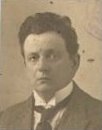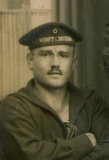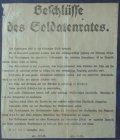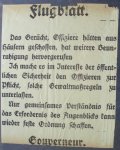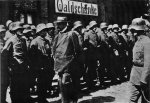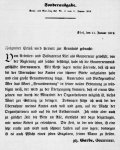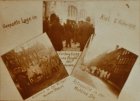Homepage Renate and Klaus Kuhl - Sailors' revolt in Kiel
Time Line Sailors' Mutiny (Sailors' Revolt) in Kiel, Germany 1918
|
Sailors and workers
|
Government and military
|
||||
|
Documents
|
Incidents
|
Date
|
Incidents
|
Documents
|
|
|
|
The workers in Österreich-Ungarn stage the Jännerstreik, because they fear that the German OHL, after the fall of the Czar and the October Revolution, will sabotage the peace with Russia by exorbitant demands. Shortly after the end of the Jännerstreik the German workers go on strike (Januarstreik). Kiel starts at 25th. On the Wilhelmplatz a workers council is elected the day after. Lothar Popp (USPD) becomes chairman. He is apprehended the next day by a military patrol and is jailed for 2 months in Neumünster. The other USPD speakers: Theil and Strunk get 2 resp. 1 1/2 years. More info (German, pdf): >> |
Jan. 1918
|
The OHL enforces its demands. The peace of Brest-Litovsk (3 March 1918) is worse than the later peace of Versailles. (7) Thereafter broad sections of the population do no longer perceive the war as defensive but as a war of conquest. |
Wihlem Deist wrote in 1991: "With ideas of conquest of an Eastern empire or the annexation of Belgium, [...] the thesis of a defensive war could no longer be upheld. This has had a huge impact on the mass of the population." (6) The engineer of the Germania shipyard in Kiel Nikolaus Andersen noted in his diary (10 Jan. 1918): "The Fatherland Party was up in arms against Kühlmann [Foreign Minister Function], they threaten with Ludendorff's [OHL] resignation because Kühlmann does not want to swallow up enough. Bunch of troublemakers." (See "Contemporary witnesses") |
|
|
After the end of the strike wave in Austria-Hungary,
sailors in Cattaro, the southern naval port of the Austrian-Hungarian
navy in the Andriatic Sea revolted; background info (German)
>>
|
1.2.
1918 |
||||
|
29.9.
|
The Supreme Command (Oberste Heeresleitung, OHL) demands from the new Imperial Government (which is based on a parliamentary majority and was installed by pressure from the OHL), the Entente to be requested for an immediate cease fire. | ||||
|
29. and 30. 10.
|
The navy command starts from Wilhelmshaven without informing the government a sortie against England, likely to end up in a huge defeat, aiming to position themselves for the next attempt to get a "place in the sun" and to secure their own future. The naval order, which was to be destroyed, was directed against the Armed Forces and Transport, in the Thames estuary and off Flanders. The possible new civilian casualties (after the sinking of the RMS LEINSTER by UB-123) would have placed the new Imperial Government again in a difficult situation. Refusals to obey orders, mutinies and sabotage by sailors from various units prevent the sailing of the fleet. On 30 Oct. Admiral Souchon becomes Gouvernor in Kiel and Chief of the Baltic Navy Station replacing Adm. Bachmann. |
Originator of the plan were Kapitän
z.S. v. Levetzow and Konteradmiral v. Trotha, chief of staff
at the high sea fleet. Trotha wrote: "The fleet looks
forward to and views such a final fight as highest goal...
even if it will be a death fight ... (from there) will ...
a new German future fleet ascend; an by disgraceful peace
enchained fleet the future is broken." (Translated
by KK) Literature review (pdf, 300 kB) >> |
|||
|
Th, 31.10.
|
The fleet commander redeploys the III. squadron to Kiel. Workers in Kiel are preparing for a general strike. Moving through the Kaiser-Wilhelm-Kanal (now Kiel canal) 48 (8) putative ringleaders of the "Markgraf" are arrested and brought from Holtenau (end of the canal in Kiel) to different military prisons in Kiel. The ships containing above 5000 personnel arrive in Kiel during the night to 1 November. | ||||
|
Shore leave for the ships' crews. In the
evening meeting of ca. 250 sailors from the III. squadron
in the union house in the Fährstraße
(nowadays renamed to Legienstraße). Delegations demand
in vain the release of their imprisoned comrades from the
ships' commanders.
|
Fr, 1.11.
|
||||
|
Reports including a police report (German; pdf) >> |
In the evening around 19 hrs. ca. 500 to
600 sailors and some civilians gather at the large
drill ground in the Viehburger Gehoelz in a demonstration.
Only the sailor Karl Artelt (Unabhängige Sozialdemokratische
Partei Deutschlands - USPD -) as a contributor moves beyond
the demand for immediate release of the imprisoned, calls
for the "overpowering of the militarism and the overthrow
of the ruling class" and seeks to join hands with the
shop stewards of the USPD. During this night the first leaflets
are printed.
|
Sa, 2.11.
|
The government in Berlin gets knowledge from the incidents in the navy. | ||
|
Su,
3.11. |
Morning: On board the 'Markgraf' 57 more sailors and stokers are rounded up. But they can only be brought to Fort Herwarth after "Zureden (beseeching)" the crew. | ||||
| 10:00 Conference of high ranking marine
officers in the Stationsgebäude of Kiel. Conclusion to
raise town alarm around 16 hrs., to prevent
sailors from attending a meeting scheduled at 17 hrs. Telegram from governor Souchon to the Imperial Navy Authority (Reichsmarineamt) including a report and the request: "... at any cost, send a distinguished socialdemocratic parliamentarian here, to talk about prevention of revolution and revolt." |
|||||
|
Virtual tour >>
|
15:30-16:00 Town alarm
without impact among the sailors; ca. 17 hrs. meeting
of about 5000 to 6000 attendees (4/5 sailors) at
the Großer Exerzierplatz (large drill ground)
with the main speakers Gustav Garbe (union chairman Kiel)
and Karl Artelt (USPD). A demonstration
to the Arrestanstalt (military prison) in the Feldstraße
starts: via Rondeel, Sophienblatt, station (a woman gets
under a tram and dies), Holstenstraße, Markt, Dänische
Straße into the Brunswiker Straße.
|
||||
|
Detailed description of
the clash, including transscription of sources etc. (German,
pdf, 1 MB) >>
Virtual tour >>
|
Ca. 19:00 Armed clash
between demonstrators and a patrol at the corner in the
Karlstraße: 7 dead and 29 injured, out of these two
die later on.
|
In the evening Souchon had requested infantry from outside, but cancelled his request after the demonstration was quelled. The authorities still believe they can manage the situation. | |||
|
Already during the night there is unrest again. In the morning armed sailors move from barracks to barracks,
partly to the site of the clash in Karlstrasse, partly
aimlessly through the city; presumably in an effort to
get soldiers and weapons to make another liberation attempt. |
Mo, 4.11.
Mo, 4.11.
Mo, 4.11.
Mo, 4.11.
Mo, 4.11. |
On the morning of 4 Nov. infantry was requested again. A unit from Rendsburg arrived at noon time and was sent to the hotspot in Kiel Wik. But before the troops reached the barracks the revolutionaries took over and Souchon had to withdraw the troops and switched to negotiations. The command in Luebeck could not be reached until 9 o'clock. These units as well as others from Neumuenster and Schleswig arrived too late and partly went over. | As regards the detailed chronologic sequence see annex of article (German): "Anmerkungen zu Ernst-Heinrich Schmidt: Heimatheer und Revolution 1918" (pdf, 100 kB): >> | ||
|
10:00 Workers of the Germania ship yard and from the torpedo workshop in Kiel-Friedrichsort down tools.
13:00 hrs. A large number of naval personnel and workers meet in the large hall of the union house.
|
At 12:30 hrs. Lieutenant colonel v. Raven received the order by telephone from colonel v. Voss, the chief of staff of the IX. army corps to go to Kiel immediately, and to take over the command of the units, which were sent from outside to Kiel, from Neumuenster, Rendsburg, Schleswig and Luebeck. He went by car from Rendsburg via Eckernoerde to the Kiel main station, where he arrived at around 17 hrs. Souchon provided two naval officers to assist Raven. | ||||
|
Virtual tour >>
|
13:00 Sailors in a large
barracks compound in a Northern district of Kiel refuse
obedience: After a Division inspection of the commander
spontanous demonstrations take place.
Upon Karl Artelt's initiative the first soldier's council is set up. Sailors, among them Karl Artelt, hand over 6 demands to the commander. Soon many more soldiers' councils are set up. |
13:30 Town commander and master of military
police admit, that they no longer control the situation. gouvernor
Souchon has to switch to negotiations and announces, the wishes
of the troups have to be reported to him instantly. Karl Artelt and other sailors go by car to the governor. On the car they carry a large red flag. |
The Commanding General of the Deputy General Command of the IX. Army Corps in Altona Falk: "Since Sunday, November 3, when the cry for help from helpless Governorate Kiel reached me in Altona, I have been unavailable here, in an attempt to gather what is left of troop units in the corps and neighbouring areas; in constant contact with the War Ministry, calling for mobile troops (1 Corps) to crush the rebellion. The swift decision - approved by the War Ministry - to rush to the promised troops, remained without success. The events were faster than me." (Letter to Trowitz from 12 Nov. 1936; BArch RM 8/1025 Bl 53-54) |
||
|
In the early afternoon the III. squadron except the "König", who has has been docked already, sets sail to Travemünde, hoping the flashpoint could be removed that way. The crews do not take part in casting off. This has to be done by ensigns and deck officers. Ca. 1000 sailors remain on shore. Ca. 15:00 First negotiation of the governor with a delegation of sailors (Artelt, Ehle, Schaaf, Fischer). The governeur agrees that the prosoners are set free. The delegation drives back to the barracks in Kiel-Wik and probably meets in front of the Wiker Postoffice a unit of Rendsburger infantry. Artelt addresses the soldiers. The unit marches back. |
|||||
|
Virtual tour >> |
Ca. 17-19 hrs Second negotiation
of the governor with sailors and representatives from the
SPD and the USPD. Their demands were communicated
to all navy units in Kiel by the governor (>>).
After a „triumphal procession" from the Wik to
the navy prisons in the in the Feldstraße several
thousand sailors receive their released comrades.
|
The governor sends a delegation to the
union house, where thousands of sailors and thereafter workplace
representatives had gathered. He invites "maßgebende
Vertreter (authoritative representatives)" of the workers
and soldiers for negotiations into the governorate.
|
|||
|
From 20 hrs. meeting of sailors and workers representatives in the union house leading to the establishment of a soldier's and a worker's council during the night. Establishment of the "14 points of Kiel". At the same evening (21-24 hrs.) third negotiations were held between Haußmann, Noske, high ranking officers, representatives of the socialdemocratic parties and sailors in the station building. Reports: >> |
19.30 The envoys from the Empire Government in Berlin, state secretary Haußmann and SPD member of Parliament Noske arrive at the central station in Kiel. | ||||
|
At sunset the war ships in the harbour
do not hoist the war flag but red flags.
|
Tu 5.11.
Tu 5.11.
Tu 5.11.
Tu 5.11.
Tu 5.11. |
Only on board the "König" the commander had hoisted the war flag. Two officers and the commander defend the flag in a shoot out. Only after they are wounded severely, the red flag is hoisted. The officers die, the commander survives. | Also on "Schlesien" the war flag was hoist. Thereafter the ship fled from the port of Kiel to Flensburg. There sailors and stokers left the ship, and Scheer included the ship in the planned operations against the rebels in Kiel (see below). Then the ship sailed via Marstal to Swinnemünde, now Swinoujscie. The approximately 200 cadets had to work as stokers. (Cadet Richter: "...it was hell, I can tell you.") More info: >> | ||
|
Virtual tour >>
|
General strike of the
workers.
In the early morning hours a worker's council is established. Gustav Garbe, SPD, is elected chairman. The council controls from 10:00 a.m. the city authorities, whereby the the top officials are not replaced but get so called by-appointees from the worker's council. Only the Food Authority is directly taken over by the worker's council. However, the judiary was forgotten. If not "wäre unendlich viel an reaktionären Bestrebungen hintangehalten worden (a great deal of reactionary attemppts could have been prevented" (Peter Hillbrecht, Vors. Volksrat in SHVZ 5.11.1919). |
||||
|
The sailors are still afraid of a counter attack from
the military. They remove the rank badges and weapons
from their officers. The sailors have the impression that
officers shoot at them out of windows in different parts
of the town. From 13-15 hrs. there extensive shoot outs
with the patrols in many parts of the town; especially
intensive in the barracks yard of the I.MD at the Feldstraße.
These end with 10 dead and 21 wounded. (More details:
>>)
The soldier's council forbids the "set-up of patrols
on own initiative (selbstständige Patrouillengestellung)"
of the sailors. |
The naval command in Berlin (SKL) does not wait for the decision of the government and sends a telegramm to the high sea fleet command, ordering in pretended consent with the government: any resistance has to be broken immediately, the IX. army corps shall shut off Kiel from the land side and the high sea command from sea side. At early evening Haußmann gets back to Berlin. In the cabinet he stands up for the demands of the sailors and stresses that the "case" can only be "held" by the social democrats and the unions. However the state secretary of the Empirial naval authority, Ritter v. Mann and the Prussian war minister, Schëuch as a warning demand strongest measures and a cordoning off of Kiel. The decision is postponed. |
Appeal of the governor to the officers
Admiral Scheer proposes to the Emperor, that Admiral v. Schröder should replace the governor of Kiel Souchon and should be deployed with a brigade to Kiel. The Emperor agrees and issues, without consulting the Government, respective orders. |
|||
| In the evening Prinz Heinrich, the brother
of Kaiser Wilhelms flees from Kiel, carrying a red flag on
his car. In the evening Noske rings Vice Chancellor v. Payer and admonishes of force. The 40,000 men in Kiel could not be overpowered and the trial would make any understanding impossible. In another communication with Ritter v. Mann Noske repeats the demands for amnesty for the sailors and retirement or resignation of the Emperor. |
|||||
|
At a large meeting Noske tries to convince the sailors
to abandon their rebellion. Popp and Garbe speak against
it. Noske's offer is turned down unanimously. Even the
socialdemocratic newspaper wrote: 'Naturally it is out
of question to stop our movement in the sense to give
up anything that can be possibly achieved.' Popp and Noske become equal chairmen of the council. (2) Upon Lothar Popp's initiative all units elect representatives. These in turn elect the Great Soldier's Council and the next day the Highest Soldier's Council. |
6.11.
|
The cabinet in Berlin accepts Haußmann's proposal unanimously, because in other coastal towns unrests are imminent. To thrash these, troups from Altona were ordered, which were actually supposed to be used in Kiel. The naval command in Berlin (SKL) affirms however their orders from the day before. |
The Empirial Government refuses the commanding of Admiral Schröder to Kiel vehemently. Scheer suggests to the Kaiser to withdraw the order, as he also has to admit that nothing can be achieved by military force any more, and the Emperor agrees. | ||
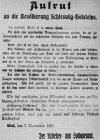
Translation of the poster into English >> |
Lothar Popp becomes chairman of the Highest Soldiers'
Council. |
7.11.
|
Gustav Noske replaces Admiral Souchon as governor, Kiel gets back to "orderly circumstances". The naval command in Berlin (SKL) affirms again their above stated orders. They are not implemented only because the necessary troups were not available, as Dirk Dähnhardt notes(3). |
Article from the Kieler Neusten Nachrichten, 10 Nov. 1918 (doc, 30 kB): Further consolidation of the situation | |
|
Scheidemann proclaims the republic in Berlin,
Karl Liebknecht the socialistic republic.
The III. squadron comes back to Kiel and and hoists the red flag as well, while coming in. The officers were not allowed to take part in the navigation of the ships. |
9.11.
|
Delegations of the soldier's council and the officers agree, that those officers, who declare in writing not to be facing the new peoples movement in a hostile manner, will be superiors again. The emperor absolves his officers from their oath. |
|||
|
Burial of the victims of the 3rd and 5th November in Kiel. In Berlin the "Rat der Volksbeauftragten (Council of the People's Deputies)" is established. Joint chairmen: Ebert (MSPD) and Haase (USPD). |
10.11.
|
The Emperor flees to Holland. | |||
|
Virtual tour >> |
Sailors and soldiers are demobilised in
large numbers.
|
11.11.
|
Cease fire is signed in Compiegne. | ||
|
Especially the submarine crews push their
claim for a trasfer bonus.
|
Su, 17.11. (9) |
According to the conditions of cease fire the III. squadron and other ships sail to Wilhelmshaven, from there to English coast waters and later for internment to Scapa Flow. Not yet moveable ships (i.a. "König") follow on 3.12. |
On 29 Nov. German submarines from Pola (Adria) enter port in Kiel. Noske welcomes the crews. Most of the ships were probably destroyed. End of Jan. 1919 two of them were towed to England (see Niemöller: Vom U-Boot zur Kanzel, pp. 147-148). |
||
|
Mid Nov.
|
Korvettenkapitän Wilfried von Loewenfeld starts secretly, however with Noske's knowledge, to set up a Free Corps. This unit is based on a conspirative association of sea officers, who want turn back the political development as much as possible. (4) On 3 Feb.1919 Canaris gets the official permission Noske's for the set up of the "Loewenfelder".They will later on during the Kapp-Putsch in Kiel (March 1920) commit a large blood bath among the workers in Kiel. |
Info on Loewenfeld (pdf): >> This photo was said to show Kiel, but its Berlin; see photo info >> |
|||
|
|
Karl Edler (MSPD) and Springer (USPD) present
a report on 26 November 1918 to the Vollzugsrat in Berlin
on the events in Kiel, including descriptions on how the
declration of 21 Nov. was developed: >>.
|
End
Nov. |
|||
|
Lothar Popp hands over the chairmanship
of the Supreme Soldiers' Council to Karl Artelt, presumably
out of resignation because the councils want to hand over
their power to the National Assembly. However, he remains
- probably pro forma - a political advisor (see "Republik"
of 11 Dec. 1918).
|
10.12.
|
||||
| 11.12. | The fact-finding commission from UK arrives in Kiel. | ||||
|
" |
The General Convention of Workers'
and Soldiers' Councils in Berlin votes to have
elections for a constituent national assembly. These elections
take place on 19 January 1919
|
19.12.
|
|||
|
The soldier's council establishes a 'Revolutionary
Security Unit' and thus wins out over Noske. The
deck- and petty officers get their own company within this
unit. (5)
|
26.12. | Ebert asks Noske urgently to come to Berlin and to become a member of the Government. | |||
| 27.12. | Noske goes back to Berlin accompanied
by Adolf v. Trotha. Gustav Garbe (secretary of the metal union
in Kiel) becomes his successor as governor. Garbe steps back
as chairman of the workers' council on 11 Jan. 1919. On 29. Dec. Noske joins the Council of People's Deputies and takes over the responsibility for "Army and Navy". |
||||
|
Karl Artelt steps back, probably bc. he
could not prevent the building of the Iron Division; successor
is at first Hartig, some days later Riefstahl..
|
Mo 6.1. 1919 |
At Noske's request, the
Deckoffizierbund establishes the Iron Division
of 1200 men; officially called: 1. Marine-Brigade. On 9 January 1919 the troup arrives in Berlin. Info: >> |
|||
|
6.1.
1919 |
Noske becomes supreme commander and leaves Kiel officially. | ||||
|
February unrest ("Spartakists'
revolt") 1919 in Kiel
|
|||||
|
External link Bremer council
republic >>
|
Bremen declares itself Räterepublik
(council republic)
|
10.1.
1919 |
|||
| Noske orders the Division Gerstenberger, in which the 1st Marinebrigade (Iron Division, Kiel) was the core unit, to march toward Bremen. | |||||
| Detailed paper including evaluation (German, pdf) >> |
500 - 1000 demonstrators in Kiel demand
weapons from the soldiers' council, to be able to support
Bremen.
Spartakists attack weapon shops and take sentries in Suchsdorf and Holtenau by surprise. |
4.2. 1919
|
Noske orders Bremen to be attacked. | ||
|
The workers of the Imperial-, Gemermania-
and the Howaldt-shipyard down tools in support for Bremen.
Spartakists seize the Marine Station der Ostsee for a short while and attack the barracks in the Annenstreet. |
We 5.2. 1919
|
The barracks are re-taken by a group from the Sicherheitswehr (security defence) of the soldiers' council, made up of deckofficers and reinforced by students and officers (in plain clothes). | |||
|
The workers' and soldiers'
council issues a leaflet >>
|
Call for general strike (heeded by the
above mentioned shipyards and the large companies)
|
6.2.
1919 |
|||
|
The radical workers give up occupied buildings.
The general strike ends.
|
8.2. 1919
|
Garbe demands the return of the weapons from the students and he releases the Spartakist leaders. | |||
|
Evaluation of the incidents
by D. Dähnhardt >>
|
Protests of the soldiers' council in Berlin
to Noske have no effect.
|
With Noske's consent the Sicherheitswehr (security defence) of the soldiers' council is put under the control of the Loewenfeld freecorps. |
|
||
| Composition of the Supreme Soldiers' Council, OSR (Kieler Zeitung 1 March 1919 M): Riefstahl (chair), Bublat, Schlüter, Klaus, Rannow, Rath, Widmaier, Thümmel, Draeger. |
5.6. 1919
|
The suspension of the soldiers's councils is ordered. | |||
|
Sept. 1919
|
Any further payment for the workers' council is refused by the mayor Lindemann. | ||||
Based on Dirk Dähnhardt, "Sichworte
- Revolution in Kiel, Vom Kaiserreich zur Republik 1918/1919",
Publisher: Landeszentrale für Politischen Bildung Schleswig-Holstein,
Germany; Dirk Dähnhardt: "Revolution in Kiel",
Wachholtz Verlag, 1978; Lothar Popp und Karl Artelt: "Ursprung
und Entwicklung der Novemberrevolution 1918"; Bernhard Rausch:
"Am Springquell der Revolution"; beide als Nachdruck
erschienen als Sonderveröffentlichung 15 der Gesellschaft
für Kieler Stadtgeschichte; Klaus Kuhl: "Streitgespräch
mit Lothar Popp", 1978; Gustav Noske: "Von Kiel bis
Kapp", Verl. für Politik und Wirtschaft, Berlin, 1920
Annotaion 1: See Dirk Dähnhardt: "Revolution in Kiel",
Wachholtz Verlag, 1978, p. 51 as well as
Rolf Güth, "Marineführung und Meuterei 1918"
in "Schiff und Zeit" 7/1978, p. 5, Hrsg. Dt. Ges. f.
Schifffahrts- und Marinegeschichte e.V.
Annotation 2: Noske and Popp give differring descriptions of these
events, see >>
Annotation 3: Dirk Dähnhardt: "Revolution in Kiel",
Wachholtz Verlag, 1978, p. 107
Annotation 4: Wolfram Wette: "Gustav Noske - Eine politische
Biographie", Droste Verlag, 1987, p. 247
Annotation 5: Wolfram Wette: "Gustav Noske - Eine politische
Biographie", Droste Verlag, 1987, p. 233 f.
Annotation 6: Wilhelm Deist: Die Ursachen der Revolution von 1918/19
unter militärgeschichtlicher Perspektive. In: Wilhelmshavener
Museumsgespräche, Texte zur Geschichte der Stadt, Band 2,
Die Revolution 1918/19 - 70 Jahre danach, Vortragsveranstaltung
der Stadt Wilhelmshaven am 28. und 29. Oktober 1988, bearbeitet
und herausgegeben von Norbert Credé im Auftrag der Stadt
Wilhelmshaven, Stadt Wilhelmshaven, Küsten Museum 1991.
Anm. 7: Becker, Jean-Jacques/Krumeich, Gerd: Der große Krieg.
Deutschland und Frankreich im Ersten Weltkrieg 1914-1918. Essen
2010, S. 272 f.
Wehler, Hans-Ulrich: Deutsche Gesellschaftsgeschichte, Bd. 4.
Vom Beginn des Ersten Weltkrieges bis zur Gründung der beiden
deutschen Staaten 1914-1949. München 2003, S. 152.
Annotation 8: Dähnhardt mentions a figure of 47 arrested
persons (Dähnhardt, Revolution in Kiel, S. 54) giving the
source Bundesarchiv-Militärarchiv F 4077/64921. This former
signature was changed into RM 8/1022 and the figures are on leaf
257. According to this source 23 stoker, who declined to work
on the boilers, 20 sailors, who declined to line up and 5 suspected
ringleaders were arrested and transfered on land. Presumably Dähnhardt
made a mistake here. (Hint given by Dr. C. Lübcke.)
Annotation 9: Although the war diary (KTB) of the naval station
mentions 18 November, there are three contemporary witnesses (Karl
Bock, Gustav Noske and Nikolaus Andersen) who all state Sunday
17 November.
Last updated 18 May 2024
| Sailors' Revolt / Kiel Mutiny November 1918 - here you'll find the following further information:
|

